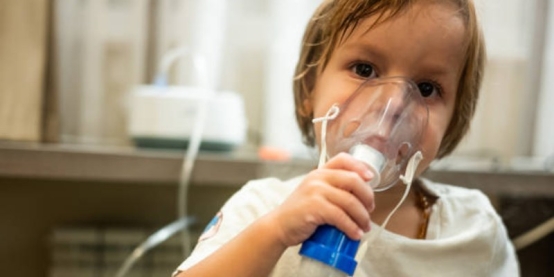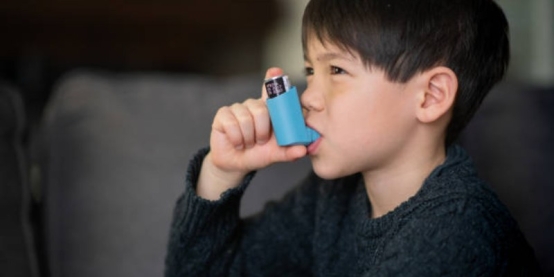Asthma In Kids: Prevention Tips For Parents
Asthma in children has become one of the most common chronic health conditions among children of the contemporary era. Parents everywhere are seeing the condition interfere with sleep, play, and overall health.
When a nocturnal cough or wheezing while playing becomes a symptom, it is generally out of the reach of families to manage. The better news is that with the proper preventive steps, parents can drastically reduce risks and allow children to live healthy, active lives. Education about asthma in children and taking action early is the key.
Understanding Childhood Asthma
Childhood asthma is a long-term condition where airways get inflamed and narrowed, making it difficult to breathe.

Common Symptoms
Shortness of breath, particularly on exertion.
Wheezing or whistling when one breathes.
Coughing at night, which interferes with sleep.
Tightness in the chest after exercise or exposure to stimuli.
Types of Stimuli in Children
Allergens: dust mites, pollen, mould, pet dander.
Exercise-induced: physical exertion, particularly in cold temperatures.
Environmental: smoke, air pollution, strong perfumes.
Viral: respiratory illnesses and colds.
Why Prevention Is Important
If asthma isn't adequately controlled, it can lead to serious outcomes such as having to be hospitalised a lot, losing lung function, and missing school. Early prevention and monitoring can minimise the use of emergency services, though. Children who can manage symptoms are more self-assured, have a better quality of life, and are healthy enough to engage in sports, school, and friendship.
Triggers That Are Prevalent Among Children
A majority of asthma attacks occur due to specific daily triggers. Parents can make a difference by staying alert to these dangers:
Environmental triggers: air pollution, smoke from cooking or fires, and potent cleaning chemicals.
Allergens include pet dander, dust mites in bedding, hidden mould, and pollen, which are present during certain times of the year.
Lifestyle-related: exercising outdoors during cold weather or unauthorised strenuous physical activity.
Medical triggers: respiratory illnesses, flu, and sinus.
Emotional triggers: laughing excessively, crying, or getting very stressed.
Parents' Tips On Prevention Of Asthma
At Home
Clean indoor air: Install good-quality air purifiers, ventilate the rooms, and avoid smoking at home.
Limit dust and allergens: Daily cleaning, HEPA-filter vacuuming, and allergen-proof bed coverings on mattresses and pillows are essential differences.
Pet control: If there are pets in a household, keep them out of the child's bedroom and bathe them regularly.
Control mould and moisture: Repair water leaks promptly and use dehumidifiers in damp areas.
Lifestyle Options
Encourage outdoor play safely: On days with a good air quality index, let children play outside so healthy lung development can occur.
Asthma-friendly exercise tips: Swimming is generally easier to manage than running when the weather is cold. Warm-up exercise before sports might avert flare-ups.
A healthy lung diet: Add antioxidant-rich foods like fruits, greens, and nuts, along with proper hydration, to your daily routine.
Healthy weight & immunity: Consistent sleep routines and a nutritious diet preserve a healthy immune system.

Medical & Preventive Care
Asthma action plan: Work with a paediatrician to create a personalised plan featuring medicines, triggers, and step-by-step responses to symptoms.
Vaccines: Vaccines and flu shots decrease respiratory infection risks. Centres for Disease Control and Prevention insists that children with asthma must get vaccinated.
Regular use of medications: Understand the difference between rescue and controller inhalers. Controllers prevent daily inflammation, while rescue inhalers treat sudden attacks.
Correct inhaler technique: Using a spacer helps children receive full doses of medicine properly.
Environmental Awareness
Daily AQI monitoring: Check air conditions via apps before outdoor play.
Seasonal allergy management: Stick to prescribed medication for allergies and close doors/windows on high pollen days.
Preparation at school & daycare: Inform teachers about the child's condition, keep inhalers handy at school, and train staff on handling emergencies.
When To Call Emergency Medical Services
Parents need to recognise when an asthma attack becomes an emergency. Red flags are:
Wheezing that does not go away with a rescue inhaler.
Inability to speak in complete sentences when winded.
Blue colour on lips or fingernails.
Chest tightness or accelerated Breathing rate. Mild attacks can improve quickly with medicines, but severe symptoms may require hospitalisation. Always follow the emergency measures as outlined in the child's asthma action plan.
Developing a Child's Asthma Action Plan
Every child should have a written action plan developed by their paediatrician. It should include:
Familiar triggers to be avoided.
Early warning signs.
Daily medications and dosage.
Emergency numbers and steps. Explaining the plan in simple, age-appropriate language encourages children to recognise their symptoms early and feel comfortable taking action.
Encouraging Your Child Emotionally
Asthma can sometimes make a child feel trapped or isolated. Parents can make this easier by:
Allaying children's fears that asthma will not rule their lives is essential.
Encouraging social participation, hobbies, and sports with adequate supervision.
Building a positive outlook by focusing on what the child can do rather than restrictions.
Educating peers, teachers, and carers to create a caring environment at school.

Common Questions Parents Ask
Is asthma outgrown? Symptoms in some children diminish as their lungs mature, but close follow-up is required.
Do plants trigger asthma? Some plants contain mould. Choose healthy varieties and give them proper care.
What are safe sports? Swimming and cycling in healthy environments are safe for individuals with asthma.
Is asthma inherited? Yes, there is a genetic component, but there's also a strong environmental contribution.
Helping Children Thrive With Asthma
Children with asthma can live active, healthy lives when parents focus on prevention, effective management, and emotional support. Keeping a clean home environment in mind, being cautious outdoors, and providing proper medical care help families keep the symptoms under control. All children need to be able to run, laugh, and sleep soundly without constantly being afraid of an asthma attack.